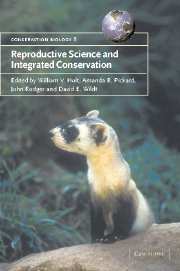Book contents
- Frontmatter
- Contents
- List of contributors
- Foreword
- Part I Introduction
- Part II Reproduction and population viability
- 2 Behaviour and reproduction
- 3 Nutrition and its interaction with reproductive processes
- 4 Environmental chemicals and the threat to male fertility in mammals: evidence and perspective
- 5 Assessing the consequences of inbreeding for population fitness: past challenges and future prospects
- 6 Impacts of inbreeding on components of reproductive success
- 7 The major histocompatibility complex (MHC) in declining populations: an example of adaptive variation
- 8 When is the birth rate the key factor associated with population dynamics?
- Part III Reproductive techniques for conservation management
- Part IV Integrated conservation management
- Part V Reproduction science in non-mammalian species
- Part VI Conclusions
- Index
- References
4 - Environmental chemicals and the threat to male fertility in mammals: evidence and perspective
Published online by Cambridge University Press: 21 January 2010
- Frontmatter
- Contents
- List of contributors
- Foreword
- Part I Introduction
- Part II Reproduction and population viability
- 2 Behaviour and reproduction
- 3 Nutrition and its interaction with reproductive processes
- 4 Environmental chemicals and the threat to male fertility in mammals: evidence and perspective
- 5 Assessing the consequences of inbreeding for population fitness: past challenges and future prospects
- 6 Impacts of inbreeding on components of reproductive success
- 7 The major histocompatibility complex (MHC) in declining populations: an example of adaptive variation
- 8 When is the birth rate the key factor associated with population dynamics?
- Part III Reproductive techniques for conservation management
- Part IV Integrated conservation management
- Part V Reproduction science in non-mammalian species
- Part VI Conclusions
- Index
- References
Summary
INTRODUCTION
Since the middle of the last century there has been a tremendous growth in the number and range of chemicals used for manufacturing processes. It has been estimated that 95% of all man-made compounds have been produced in the last 50 years. Inevitably, some of these chemicals pollute the environment. This may be caused by deliberate release, such as products to manage agriculture (e.g. herbicides, fungicides and pesticides); incidental release, such as waste products of industrial processes (e.g. sulphur dioxide and acid rain, dioxins, detergents and heavy metals); accidental chemical spills (e.g. oil tanker disasters, sewerage outflows); or the pervasive and continuous pollution of substances merely because of lack of proper controls and care. This environmental pollution, and the effects it might have on nature, has been recognised for many years and was highlighted by well-known scientists and ecologists (Carson, 1962). The stability and persistence of many man-made chemicals in the environment with their eventual distribution throughout the food chain is of very real concern and, although the apocalyptic forecasts of the destruction of nature from chemical pollution might now appear excessive, there have been enough examples of the effects of environmental chemicals on reducing animal populations for the need to be vigilant. Some classic examples of the effects of environmental chemicals on reproduction in vertebrates serve to illustrate this point. From 1950 to the 1970s, the organochlorine DDT (1,1,1-trichloro-2, 2-bis (p-chlorophenyl) ethane) was used profligately as a general pesticide.
- Type
- Chapter
- Information
- Reproductive Science and Integrated Conservation , pp. 57 - 66Publisher: Cambridge University PressPrint publication year: 2002
References
- 1
- Cited by



